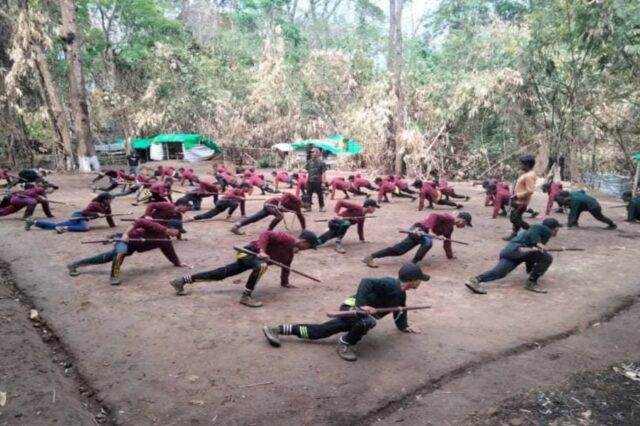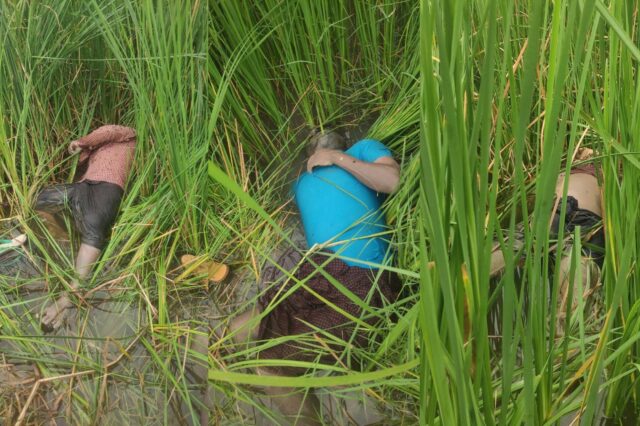Mawlaik Township
Two other murders took place in northwestern Sagaing’s Mawlaik Township, where teenagers staying in an IDP camp near Ma Gyi Tan village were abducted in a junta raid on the site on June 8 and subsequently killed, their bodies found later that day.
“The children were captured and forced to carry the soldiers’ bags and guide them around the area before ultimately getting killed,” a 50-year-old woman from the area told Myanmar Now.
They were identified as Sithu and Phyo, both in ninth grade, but whose exact ages were not known.

Mawlaik PDF members are seen undergoing training in April of this year (Mawlaik PDF)
Moe Di, spokesperson for the Mawlaik PDF—which clashed with the junta column in question on the day of the raid on the camp—confirmed the death of the two boys, saying that their bodies were found with knife wounds and their hands tied behind their backs.
Myanmar Now was unable to obtain photos of the victims due to the ongoing military-imposed internet blackout on much of Sagaing.
The military unit combined with another coming from Kalay to the south, forming a new column of some 150 troops in Mawlaik on June 10 before focusing their assaults on villages on the western shore of the Chindwin River, Moe Di explained.
A PDF member was killed in a battle which took place with the Myanmar army that day, but the resistance group was not able to inflict any casualties, the spokesperson said, adding that his fighters were forced by heavy artillery fire to retreat.
“We had to withdraw because there was no way for us to defend against such a weapon,” Moe Di said, adding that clashes were still ongoing at the time of reporting.
Hundreds of homes were burned by the military over the next four days, including almost all of the residences in the village of Ma Gyi Tan, as well as houses in Yuwa and Tat Kone, locals said.
Some 5,000 residents from a total of five communities were forced to flee the arson attacks—which the military has repeatedly denied perpetrating nationwide—to the eastern shores of the Chindwin.
The telecommunication cuts have meant that an assessment of the extent of the damage was still ongoing at the time of reporting.
Depayin Township
A 30-year-old man in Depayin Township narrowly escaped death during a military raid on his village of Muu Kan Gyi on Tuesday, describing to Myanmar Now how he hid and witnessed more than 75 troops burning 200 other residences.
“I could see them from the house I was hiding in. They seemed to be enjoying torching the houses,” he said.
The building in which he had sought refuge reportedly failed to catch fire.
“One of the army officers they called Kyaw Tun gave them permission to burn the house and two soldiers came inside to torch it,” the man recalled. “I could smell alcohol on them while I was hiding under the bed. I would have been killed if they found me.”
He emerged after the troops left the following morning to find that his own house had been destroyed, along with his food stores.
“I wish nothing but death on them,” he said of the junta troops. “They’re funded by our tax money, and they are terrorising us.”
Locals said that the same junta column that torched Muu Kan Kyi had previously burned the villages of Ywar Soe and Pauk Chaing in neighbouring Shwebo Township over the weekend, and had gone on to occupy the communities of Ti Pin and Htoo Gyi, all located along the eastern bank of the Muu River.
A local anti-junta defence force, Min Ma Naing Thein Nghat, reportedly tried to drive out the unit from the village of Ye Kyi Wa, across the Muu River from Muu Kan Gyi—which is situated on the western shore—but they ultimately were forced to retreat by the difference in firepower, the guerrilla group’s leader said.
“They relentlessly fired both 60mm and 40mm shells at us from the other side of the river. That’s why we had to withdraw,” he told Myanmar Now, adding that a 30-year-old resistance fighter was killed in the clash.
The leader emphasised the need for the civilian National Unity Government to arm forces like Min Ma Naing Thein Nghat, noting that there was only one gun for every three members of his group.
“We have to face the junta with handmade rifles and 10 to 15 bullets while 100 percent of the junta personnel are armed with a rifle each,” he explained. “If only they could arm us properly, there isn’t any reason we wouldn’t win over the military.”
Reporting by Thura Maung, Khin Yi Yi Zaw and Ko Cho
Original post: Myanmar Now



